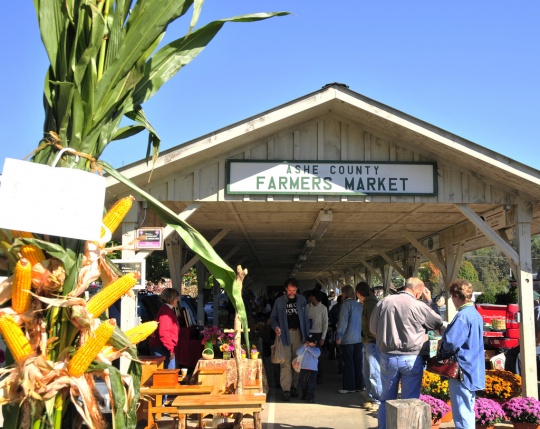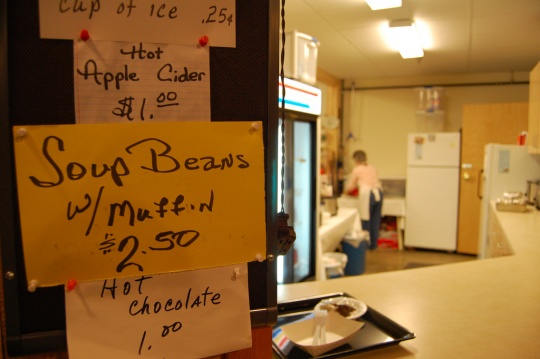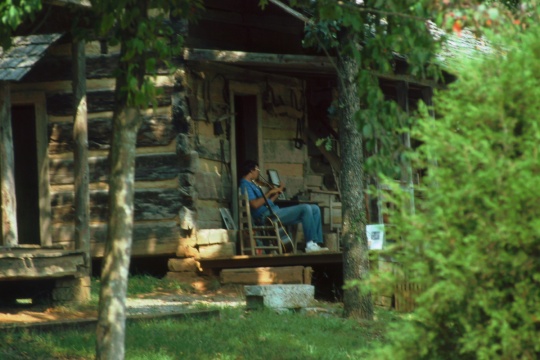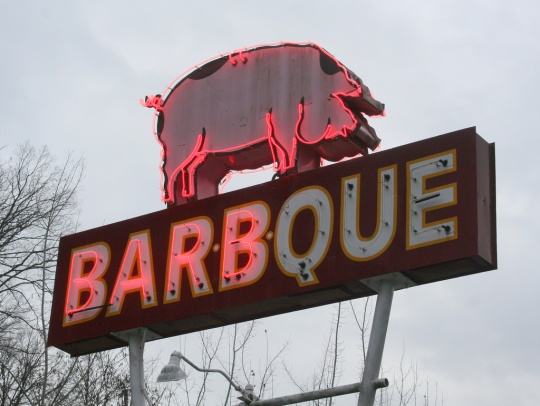Eating Appalachia: The Pursuit of Fried Squirrel

In this second installment of a four-part series exploring Appalachian cuisine (read part one here), Eat Me Daily’s Kathleen Willcox explores the rapidly evolving culinary scene across Appalachia. With recipes! Today, we're looking for places to get some real, authentic Appalachian grub.
What does a girl need to do to get some fried squirrel and boiled groundhog up in here? For all the talk of Appalachia's family farms, robust produce, and idiosyncratic recipes, the true test is tracking the real stuff down. Traditional dining is getting harder and harder to come by as fast food chains, ho-hum burger joints and fancified but ultimately uninspired and insipid takes on cuisine you can just as easily find in Bloomfield Hills, Michigan or Greenwich, Connecticut.
I figured if anyone had fried squirrel, it would be the ground zero for authentic (if old-school) Appalachian culture: Clinton, Tennessee's Museum of Appalachia. The throngs of tourists might think they're coming for enchanting exhibits of traditional quilts, toys, musical instruments, baskets and furniture, or for glimpses of whimsical beauty amid hardscrabble lives. But what they wind up staying for is the food, so irresistable that it's a favorite among locals as well, who come daily sniffing their way down memory lane for fried green tomatoes, fried apple pies, and meat and two — a meat of the day with the choice of two sides.

Photo by jsrice00
From Farmers to Miners
The kitchen at the Museum of Appalachia is run by Faye Smiddy, who is almost 85 and has no plans to retire anytime soon, thanks very much. Smiddy vividly recalls both a carefree life on her family farm and a very different one in a coal-mining camp: “I lived on my family’s farm until I got married,” she told me. “My mother starting teaching me how to cook as soon as I could sit up. We grew all our own vegetables and meat too – beef, pork and chicken. The only time we all left the farm was for coal-mining camp in 1931; we lived there for 10 years or so because dad could make more in the coal mines. But life in the camps wasn’t as good – especially the food.”
That's more than just one woman's opinion. The coal-mining industry dropped on the region with all of the grace of an atom bomb. When coal mines came to Appalachia, they knew they’d hit more than mere anthracite – they’d hit pay dirt. Well into the 20th century, coal industry bigwigs found makeshift roads, zero electricity and a population of willing workers who up until that point had spent their whole lives farming, trapping, hunting and cutting timber.
While some fled the reach of the mining corporations, many were attracted by the steady work and decent pay. While they brought with them better roads and electricity, the mines also did fine work breaking down the region's reliance on family farms. Smiddy and her eight siblings were hardly the only ones directly affected by the coal-mining industry’s steely-eyed determination to force-feed modern times (and modern food) down locals’ throats.

Photo by Southern Foodways Alliance
You Can Take it With You
The radical lifestyle change brought by the mining industry nearly demolished the old ways of life, and in response, people like Smiddy have made careers out of undoing what the mines have done, devoting themselves to the preservation of traditional Appalachian dishes, sharing them with younger generations, and laughing in the face of the Applebee's reign of terror.
While Smiddy doesn’t live on a farm anymore, she loves serving traditional Appalachian food to people who’ve never experienced it – especially in the spring and summer, when she can gather fresh ingredients from the museum’s garden.
“Kids in Appalachia don’t eat the way they used to, but no matter what they’re used to, our chicken n’ dumplings are always popular,” Smiddy said. “The tourists love it too. Everyone loves chicken n’ dumplings! Oh, and the desserts – the Appalachian Cream Pie and the Fried Apple Pies are always the first to go.” Sadly for my search, there's no fried squirrel on the menu. But if you call ahead, Smiddy will happily set aside an entire pie or cake so you can take it home with you.

Photo by rjones0856
A Return to the Roots
In pursuit of that crispy fried-up rodent, I chatted with the communications and marketing coordinator at the Appalachian Sustainable Agriculture Project, Rose McLarney. The ASAP, based in North Carolina, helps family farmers find markets in restaurants, hospitals, and cafeterias. While McLarney couldn’t help me with my squirrel hunt, she did give me hope about the future.
“We’re seeing a huge resurgence of interest in traditional Appalachian foods,” McLarney said. “Younger farmers are getting interested in growing both heritage vegetables and tending to heritage varieties of meat. They’re committed to sustainable growth practices and grass-fed meat – they’ve found that both the vegetables and the meat tastes fresher and better when it’s cultivated naturally and residents and restaurants are responding."
One of ASAP's goals is cultivating interest in Appalachia's agricultural heritage, and it's working. McLarney continued: "People are recommitting to preserving their cultural roots. They’re committed to going out to local farmer’s markets every week to connect with the people who grew their food instead of just buying something in a grocery store. The influx of convenience foods definitely changed many people’s diets and their approach to food for a long time, but I really see people taking a step back and reassessing.”
David Darugh, the webmaster for the Georgia Mountains Foodways Alliance and the owner and operator (along with his wife Gayle) of the Beechwood Inn in Clayton, Georgia, agrees: “We’ve been shocked by the response to the Foodways Alliance,” Darugh said. “At our first meeting two years ago, we were expecting five people. Eighty showed up; and now we have dozens of small farmers, wineries, orchards, basically any form of farm-to-table producers, involved. Every generation for the last 100 years or so got farther away from living off the land and traditional cuisines, but now people are starting to realize just how much they stand to lose for the sake of convenience and they’re banding together before the traditions are gone forever.”

Photo by Jacob...K
Taking Fried Squirrel into Your Own Hands
So is fried squirrel gone forever? Sure, it's a little bit of an Appalachian cliche, but all cliches start somewhere. Other than borrowing pa's gun and taking matters into your own hands, there's got to be a way.
If you happened to be around when the Travel Channel’s Bizarre Foods with Andrew Zimmern zipped into Showshoe, West Virginia, you might have had the chance. Brian Bell, head chef at Snowshoe's Embers Restaurant, lured Zimmern and his crew to tape him at work with squirrel – even though he’d never before cooked the critter. The result: squirrel au vin, chicken-fried squirrel, and skewered squirrel leg. Ball and his crew didn’t stop there — they really get to the good stuff, cracking open the skulls, old-school style, and eating the brains. “I guess the flavor reminded me of foie gras,” Ball told the Charleston Daily Mail. “It had a really smooth, velvety texture. It was a little like the texture of hard-boiled egg yolk, but smoother.”
But since the Andrew Zimmern roadshow has packed up and left town, and Ball hasn't put squirrel on his permanent menu, there's an easier option: TheWest Virginia Road Kill Cook-Off, an annual autumn harvest festival where the discerning glutton can sample possum, groundhog, polecat, squirrel gravy, bear, and other culinary delights. This year it's September 26th, and the squirrel will be a-flowing.
Recipe: Faye Smiddy's Fried Apple Pie
If you don’t can’t up and high-tail it to Appalachia, but you all this talk of fried deliciousness has you hankering for some home-cooking here’s a recipe courtesy of Faye Smiddy at the Museum of Appalachia, that should hit the spot:
Ingredients:
6 Cups of Granny Smith Apples (cored, peeled and chopped)
1 tsp. Salt
3 tsps Allspice
3 1⁄2 cups sugar
3⁄4 cup water
4 cups all-purpose flour
2 tsps baking powder
1 tsp salt
1⁄2 cup milk
1 1⁄2 cup shortening
1. Mix apples and next 4 ingredients and cook on medium heat until thick. Set aside.
2. Cut shortening into dry ingredients until crumbly. Add milk.
3. Roll out dough on floured surface and cut into 6 inch round shapes.
4. Put about 2 tablespoons of apple mixture in the middle of the dough, fold over once into a half round shape. Crimp the edges with a fork to seal.
5. Fry in hot oil (not too much!) until golden brown.
Makes approximately 16-18 individual-serving apple pies.
— Kathleen Willcox
Earlier on Eat me daily:
No comments:
Post a Comment